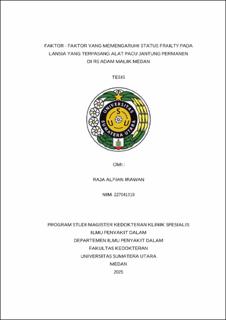| dc.contributor.advisor | Ariestine, Dina Aprillia | |
| dc.contributor.advisor | Lubis, Anggia Chairuddin | |
| dc.contributor.author | Irawan, Raja Alfian | |
| dc.date.accessioned | 2025-06-16T04:38:21Z | |
| dc.date.available | 2025-06-16T04:38:21Z | |
| dc.date.issued | 2025 | |
| dc.identifier.uri | https://repositori.usu.ac.id/handle/123456789/104370 | |
| dc.description.abstract | Background: The prevalence of frailty among the elderly population is reported to be over 70% in patients after permanent pacemaker implantation. Several factors can influence frailty scores based on the Comprehensive Geriatric Assessment (CGA). Key components of CGA include the Mini Nutritional Assessment (MNA), Charlson Comorbidity Index (CCI), Barthel Index of Activities of Daily Living (ADL), Mini Mental State Examination (MMSE), Geriatric Depression Scale (GDS), quality of life, polypharmacy, duration of pacemaker implantation, and social conditions such as age and gender. Identifying risk factors is crucial to improving the quality of life in elderly patients with frailty after pacemaker implantation. Objective: To determine the factors affecting frailty scores in elderly patients with permanent pacemakers at H. Adam Malik Central General Hospital. Methods: This was a cross-sectional study conducted from October to December 2024 on patients aged ≥60 years with permanent pacemakers at the Arrhythmia Outpatient Clinic of Adam Malik General Hospital. Bivariate analysis using Fisher’s exact test and Chi-square test was performed for all variables. Multivariate analysis was conducted using logistic regression to assess associations with frailty scores. Results: A total of 62 subjects were included, with the majority aged 60–74 years (62.9%). Among elderly patients with pacemakers, those at risk of malnutrition experienced frailty in 58.1% of cases (p < 0.008). Patients with polypharmacy showed a higher prevalence of frailty (94.1%) (p < 0.001). Multivariate analysis revealed a statistically significant association between polypharmacy and frailty scores, with an odds ratio (OR) of 14 (95% CI: 2.186–89.675).
Conclusion: Nutritional status and polypharmacy are factors that influence frailty status in elderly patients with permanent pacemakers. However, after multivariate analysis, only polypharmacy remained statistically significant. | en_US |
| dc.language.iso | id | en_US |
| dc.publisher | Universitas Sumatera Utara | en_US |
| dc.subject | Permanent Pacemaker | en_US |
| dc.subject | Comprehensive Geriatric Assessment | en_US |
| dc.subject | Frailty | en_US |
| dc.title | Faktor – Faktor yang Memengaruhi Status Frailty pada Lansia yang Terpasang Alat Pacu Jantung Permanen di RS Adam Malik Medan | en_US |
| dc.title.alternative | Factors Affecting Frailty Status in Elderly Patients with Permanent Pacemaker Implantation at H. Adam Malik Central General Hospital, Medan | en_US |
| dc.type | Thesis | en_US |
| dc.identifier.nim | NIM227041019 | |
| dc.identifier.nidn | NIDN0011048103 | |
| dc.identifier.nidn | NIDN0003078102 | |
| dc.identifier.kodeprodi | KODEPRODI11103#Ilmu Kedokteran Klinis | |
| dc.description.pages | 123 Pages | en_US |
| dc.description.type | Tesis Magister | en_US |
| dc.subject.sdgs | SDGs 3. Good Health And Well Being | en_US |


